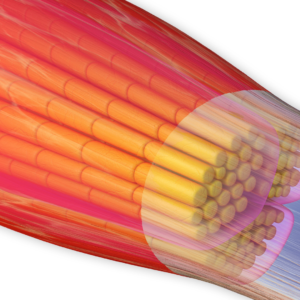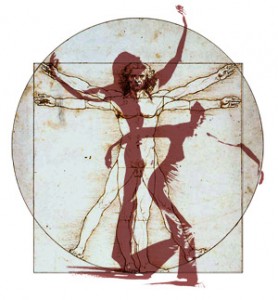What is Fascia and How to Keep it Fit with Nia
About 10 years ago, while I was working at Toronto Rehab in their outpatient stroke program, I was introduced to a term through my physiotherapy colleagues.
Fascia.
At the time, all the physios were going on courses to learn the Myofascial Release Technique.
I’m sure they tried their best to explain the concept of fascia and the need to “release” it, but at the time, it didn’t really resonate. In short, I didn’t get it.
In fact, I didn’t quite understand it until I started teaching Nia 6 years ago. I attended a workshop given by Sandy Feldstein, a Black Belt Nia Instructor and only then did it begin to make sense.
And the more I’ve learned about fascia, the more I’m convinced that Nia is an ideal way to keep the fascia stretched, fit and to avoid connective tissue injuries.

So, what is fascia?
Wikipedia defines fascia as:
“… a layer of fibrous tissue. A fascia is a structure of connective tissue that surrounds muscles, groups of muscles, blood vessels, and nerves, binding some structures together, while permitting others to slide smoothly over each other… ”
When I was first given this type of technical/scientific definition of fascia, I was still confused. But Sandy offered this “Fascia for Dummies” explanation, which was much more clear:
“… it’s a net-like casing that holds the muscles together. It’s like sausage casing; the ‘skin’ that holds the sausage meat together… like Saran wrap that holds a sandwich together… it is also referred to as “connective tissue.”
Ok, now that made sense.
From there, I’ve learned through my Nia training and reading that fascia is actually a little more than just some kind of plastic wrap for the muscles.
Here are some interesting facts about fascia:
- the fascia is actually one big net with no separation from the top of your head to the tips of your toes, so any time you are moving any part of your body, your fascia is being moved.
- every cell in your body is hooked into the fascia and responds to how much tension it is experiencing.
- fascia not only stabilizes but is responsible (in part) for regulating our mechanics.
- when we are “feeling” our muscles moving, we are actually feeling our fascial tissues to a greater extent than our muscles.
- like our muscles, the fascial tissue needs stretching, strengthening and to be trained to be resilient / elastic as well as coordinated.
- when you stretch and release the fascia, you are helping to build power and strength in the fascial system.
- there are 10 times more sensory nerve endings in the fascia than in our muscles, which is why we “feel” fascia more than our muscles.
- many of the injuries we experience are, in fact, injuries to the fascia NOT the muscles. A common one is plantar fasciitis, which I have written about here.
I’ve always thought in terms of keeping my muscles fit and toned, but now understand that it’s equally (if not more) important to keep our fascia in good shape too!
How does Nia keep the fascia fit?
 By moving the Body’s Way, of course! In Nia, we use the design and structure of the body to inform our movements.
By moving the Body’s Way, of course! In Nia, we use the design and structure of the body to inform our movements.
1. The fascial system responds better to variation than to a repetitive program
A variety movements with varying tempo, directional challenge and degrees of intensity respects the fascia’s need to be ready to respond to the extreme variety of movements that come along in everyday life.
How does Nia do this?
- by offering a variety of movements drawn from 9 different movement disciplines spanning the martial arts, dance arts & healing arts.
- by offering whole-body movements which engage the long myofascial chains.
- by offering lots of reaching and extension through the limbs and spine training the elasticity / resilience of the fascial system.
- by offering training in agility, the ability to start & stop movements along with strength, flexibility, mobility and stability.
- by playing with tempo of movements (slow/fast) to fascial strength and elasticity.
2. The fascial system is has far more sensory innervation than muscles, so proprioception (knowing where you are in space) and kinesthesia (sensation/awareness of movement) are primarily fascial, not muscular.
As I mentioned earlier there are 10 times as many sensory receptors in your fascial tissues as there are in
your muscles. In order to be fit and to prevent injury, the fascia need proprioceptive training.
How does Nia do this?
- by offering skin and surface tissue stimulation; touch and self-massage is a part of nearly every Nia class.
- by encouraging participants to “listen” to the voices of their body. Nia instructors continually encourage students to check in with their bodies to ensure that they are making movement choices to create pleasure (and avoid pain). In this way, we are training kinesthetic acuity enhancing injury prevention.
Thanks to Thomas Myers (author of ‘Anatomy Trains’) at IDEA who inspired me to write on this topic after I read his post about fascia.
And to the folks over at Japanese Jiu Jitsu: A Journey for the informative post on this topic.
Read more about the Awareness of Connective Tissues over at www.nianow.com


I didn’t know you’re work before. I am a Blue Belt Nia Teacher. I am looking forward to meet you some day. Thanks.
Great post! The fascia is actually a single tissue that covers the body from head to toe and connects its every part inextricably with one another. It acts like an individual wrapping for every internal part, keeping it separate from the rest. Largely ignored till recent times, mainly because of its undefined function and messy appearance, modern research has revealed the extent of the impact of fascia on muscle strength, bio mechanics and athletic performance. For more on how to maintain the fine balance between elasticity and tension in the muscle fascia to enable the best physical equilibrium please visit http://lovefitnesseducation.com/2012/08/21/understanding-muscle-fascia/